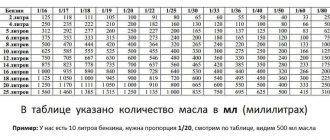Gasoline trimmers have long been used by many summer residents and owners of personal plots.
Their convenience is undeniable, because operation does not require a stationary power source, and the absence of electrical wires allows you to use these devices away from home.
With all this, the devices are quite powerful, and there are professional models among them.
To operate any gasoline trimmer, 2 types of fuels and lubricants (fuels and lubricants) are required, that is:
- petrol;
- oil.
However, the operating principles of two-stroke and four-stroke engines of lawn mowers are different, and this determines how much oil needs to be added per liter of gasoline and what kind of oil can be poured into the engine.
Therefore, next we will tell you:
- how the lubrication system of two-stroke and four-stroke engines works;
- what is the difference between oils for different types of engines;
- what kind of gasoline and what kind of oil is best to pour into a lawn mower with different types of engines;
- what happens if you confuse the type and method of using oil;
- how to dilute gasoline with oil for a lawn mower with a two-stroke engine;
- how much lubricant to pour into four-stroke engines;
- What are the fuel consumption standards?
How much oil should I pour when running in a petrol mower?
Thus, if for the operation of lawn mowers
it is necessary to fill it with an oil-gasoline mixture in a ratio of 1 to 50 - 20 cm²
of oil
per liter of unleaded fuel, then in the running-in mode the mixture should be dosed in a ratio of 1 to 25 - 40 cm²
of oil
per liter of gasoline.
Interesting materials:
When should trees be sprayed with urea? When to apply varnish to wood? When to spray trees with copper sulfate? When to perform sanitary pruning of trees? When to plant a raspberry tree? When are Simirenko apples removed from the tree? When to spray trees with copper sulfate in spring? Who is responsible for the trees in the local area? Who is responsible for the trees in the yard? Where to go to have a tree cut down?
Lubrication system for two-stroke and four-stroke engines
Four-stroke engines and air-fuel mixture preparation
systems Therefore, the pump supplies oil directly to the rubbing surfaces, that is, the crankshaft bearing and the point of contact of the piston with the cylinder walls.
To do this, the lubricant is poured into a special container, from where it flows through channels to areas of high friction.
In addition, through the crankshaft and connecting rod, oil reaches the piston and washes it , reducing the temperature and lubricating the cylinder walls.
Two-stroke engines do not have a separate lubrication system, but they also have a crankshaft bearing that needs to reduce friction.
In such power units, the air-fuel mixture first enters the crankcase, where the crankshaft bearing is located, and then, under the influence of vacuum, passes by the piston, cooling it and lubricating the cylinder walls, and enters the combustion chamber.
However, gasoline does not have lubricating properties, so such devices are filled with a gasoline mixture, that is, liquid fuel to which special oil has been added.
The efficiency of lubrication with a fuel mixture is much lower than with engine oil, so the service life of a two-stroke engine bearing, and therefore the crankshaft and connecting rod, is noticeably shorter than the same part of a four-stroke engine.
In addition, the two-stroke lubrication system places special demands on the oil, because it must burn as much as possible in the cylinder and form a minimum of toxic substances.
Safety precautions when operating a chainsaw
First of all, the manufacturer indicates in the instructions the importance of having special protective clothing, shoes and accessories. So, for example, for safe work you should acquire:
- closed, comfortable shoes, preferably with metal edging;
- fitting, but not restricting movement, clothing;
- non-slip, thick gloves;
- safety glasses;
- a helmet or special noise-absorbing headphones.
The Partner 351 chainsaw is controlled with only two hands. Using the saw with one hand can cause injury and injury not only to the operator, but also to those around him. Since the gasoline drive produces harmful and toxic exhaust, Partner 351 is prohibited from working indoors or in poorly ventilated areas.
What happens if you mix up the type and method of using oil?
If you pour mixture for a two-stroke into a four-stroke engine, the following will happen::
- power will drop;
- fuel consumption will increase;
- spark plugs will quickly fail;
- during long-term operation, the gasket, valves or piston may burn out;
- the smoke will become darker and smellier;
- Over time, the carburetor will clog, so the engine will run poorly even with the right gasoline.
If you pour oil into the fuel instead of the crankcase, then in addition to the troubles described, the crankshaft bearing will soon first knock and then jam, because it cannot work normally without lubrication . If you pour pure gasoline into a two-stroke engine, it will soon fail, because the crankshaft bearing will lose its lubricant.
If you mistakenly add four-stroke oil to the fuel mixture for a two-stroke engine, then:
- the crankshaft bearing will quickly fail;
- over time, the operation of the carburetor will be disrupted;
- valves, piston or gasket will quickly burn out.
Huter GGT-1500TX
Warranty and service official guarantee at the company service center
Description
The power of the Huter GGT-1500TX is 1.5 kW, which, along with the features of the cutting tool (line/knife), classifies it as a semi-professional class of similar devices. Therefore, the model can be used not only in dachas and country farms, but also in small farms. The GGT-1500TX will do an excellent job of both mowing grass and tidying up areas with small bushes. The trimmer weighs 6.78 kg, which makes transportation relatively simple, including in a regular passenger car.
Advantages of Huter GGT-1500TX
- The presence of a two-stroke gasoline engine makes the device more autonomous compared to electric types of lawn mowers.
- The engine is distinguished by sufficient power to solve problems and high reliability. It is also equipped with an anti-vibration system and is easy to put into operation.
- The trimmer design includes a translucent fuel tank, which is convenient to fill with fuel and monitor its level.
- There is a convenient and reliable trimmer control system located on the ergonomic handle.
- The 1500TX boom has a split mechanism for easy and convenient transport.
- The trimmer is easy to disassemble and assemble, but when assembled it is distinguished by the reliability of all components and fastenings.
- Included with the model, the buyer receives a comfortable backpack-type belt, goggles to protect the eyes during operation, and a 40 TP disk.
Work conveniently and safely
Of course, the operator must follow all recommendations and safety requirements and follow the rules for operating the trimmer. However, in addition to this, the manufacturer has taken a number of measures regarding the design of the device to increase the level of safety when working with the lawn mower. These include in particular the presence of:
- protective cover to prevent flying stones and debris from hitting the user,
- trigger that blocks the gas so that the operator cannot accidentally pull the trigger and start rotation
- cutting tool when the engine is running,
- anti-vibration system to prevent the harmful effects of the vibrating elements of the trimmer on the hands and other parts of the operator’s body.
Features of operation of Huter GGT-1500TX
The assembled trimmer can now be prepared for upcoming work on the site. Preparation for operation begins with preparing the fuel mixture. At this stage, follow all the manufacturer’s recommendations regarding the brands and quality of fuel mixture components, and also accurately follow the procedure for preparing the fuel mixture, which, in reality, is not very difficult.
Since the Huter GGT-1500TX is equipped with a two-stroke air-cooled engine, to prepare the fuel mixture you need high-quality oil, specially produced for this type of engine. According to the classification, this oil is API TV/API TC, JASO FB/JASO FC. It is recommended to use oil produced by Huter itself under the label Huter 2T. The second component of the mixture must be high-quality gasoline with an octane number of at least 92. The use of oils produced for water-cooled engines in the fuel mixture is strictly prohibited. The fuel mixture is prepared in a ratio of 1:40 (1 - oil, 40 - gasoline) or according to the recommendations of the oil manufacturer.
For the process of preparing the mixture, use a special measuring container. The amount of mixture should be calculated for only one cycle, so that after completion of work there is no residual fuel mixture in the tank (it cannot be left in the tank until the next cycle of work). Also, never use the tank itself to prepare the mixture, and also do not perform operations with the components of the fuel mixture near the fire and do not smoke while preparing the fuel.
After the correctly composed fuel mixture is poured into the tank, you can proceed to the actual preparation of the trimmer for work. To do this, the user must first put on a backpack-type belt and fasten it securely, but comfortably. After this, using a special carabiner, the trimmer is attached to the belt and adjusted if necessary. For details on preparing the trimmer for use, see the User's Manual.
What gasoline is suitable for different types of engines?
The motor of any trimmer, regardless of type, is designed to run on AI-92 unleaded gasoline.
However, the engine can also operate on other types of gasoline, for example, AI-76 or AI-95, but this is only permissible for a short time, that is, tens of minutes.
Long-term operation on unsuitable fuel will lead to burnout of valves and other problems , after which the power unit will have to be repaired or replaced, so you need to know exactly what kind of gasoline can be filled with your specific model of brush cutter.
Why buy trimmers?
When comparing with similar mechanisms, when choosing, they give preference to brush cutters based on the following functional indicators:
- The mobility and light weight of the unit allow it to be transported over distances and used in hard-to-reach places for mowing.
- Versatility. The brush cutter is equipped with a unit for changing working elements directly during operation of the unit.
- Simplicity of design allows you to use the scythe for a long time without frequent adjustments.
These other positive characteristics give buyers confidence that when purchasing a trimmer, they are making the right choice.
Signs of misuse
The introduction of contaminated or disproportionate consistency can lead to serious malfunctions in the operation of the motor. If you make a mistake when mixing, it’s okay, because the car itself will tell you about it. You just need to be attentive to certain signs, including:
- The appearance of dirt and various deposits on the carburetor.
- Rapid contamination of the fuel filter located in the gas tank.
- Oxidation of the carburetor walls and loss of elasticity of the rubber diaphragm in different parts of the gas tank. This symptom appears only when the unusable consistency is stored for a long time in the gas tank of a car.
Consumption rates for fuels and lubricants
Fuel consumption for gasoline trimmers depends on:
- engine power;
- engine volume;
- state of the power unit;
- grass characteristics;
- operator skills.
Therefore, fuel consumption is individual for each engine, and also changes in different situations.
This parameter is measured in various units, the most popular of which are:
- g/kWh (grams per kilowatt-hour of engine power);
- l/hp h (liters per horsepower per hour);
- liters per square meter or hundred square meters (100 m2).
Manufacturers do not always indicate the actual fuel consumption of this or that trimmer, so the owner of such a device will have to find out this parameter experimentally. Usually this parameter fits into 0.3–2 liters per hundred square meters .
Oil consumption for two-stroke engines is always tied to the amount of fuel and corresponds to the fuel mixture ratio set by the lubricant manufacturer.
The amount of oil for a four-stroke engine is always the same, because it is changed once a season.
Consequences of filling with a mixture with incorrect proportions
When diluting fuels and lubricants, it is very important to follow the ratio recommended by the brush cutter manufacturer. If there is not enough oil, scuff marks will form on the piston and cylinder, which will sooner or later lead to breakage of the piston ring.
Important! In addition, as a result of friction, the metal from the piston settles on the cylinder walls, and the engine may simply jam. This will require repair or replacement of the motor.
And if there is an excessive amount of oil, coking of the piston ring occurs, as well as the formation of carbon deposits on the piston, on the spark plug, etc. All this leads to severe wear and tear on the equipment and the need for constant cleaning.
How to fill with fuel?
In four-stroke trimmers, pour both liquids into the corresponding holes, closed with sealed lids.
If you spill any liquid during pouring, remove it with a clean, dry cloth , do not leave it on the body.
Two-stroke engines have only one hole for pouring mixture into the tank.
Remember, the mixture for two-stroke engines must be used within two weeks, after which the mixture will lose its lubricating properties, so the crankshaft bearing will run dry without lubrication, which will lead to it seizing and expensive repairs.
the fuel using a funnel, so there is less chance of spilling it , but with sufficient skill, it can be poured immediately from a mixing canister or even a plastic bottle.
Varieties
In order to choose the right liquid for gardening equipment and always know what to buy, you need to study the existing types of oils. First of all, technical oil liquids are divided according to their chemical composition.
There are several other classifications based on different requirements. The most common classification is API. It is supported by different countries and many manufacturers. According to this classification, all motor oils are divided into the following types:
- TA is the best option for household appliances with a motor up to 50cc. cm;
- TB is intended for equipment with higher power, equipped with an engine capacity of more than 50, but less than 200 cc. cm;
- TC is an oil that is intended for engines with increased requirements for the quality of the lubricant; this oil can be safely poured into lawn mowers;
- TD is developed for outboard motors that are equipped with liquid cooling.
Due to its 20% solvent composition, two-contact oil can mix well with automotive fuel. In addition, such liquids can burn completely. Lubricants can be painted in various colors. Coloring does not indicate the quality of the oil. Its function is different - it makes it easier for the user to distinguish the lubricant from the fuel.
Fuel to Oil Ratio for Two-Stroke Engines
Oil for such engines is supplied in different concentrations, so for one part of lubricating fluid there are 20–50 parts of fuel , and the correct ratio is indicated on the packaging or container with oil.
To make the right mixture, use special containers (canisters), which indicate the volume of contents at different levels.
First, the optimal proportion of both liquids is determined, then the required amount of gasoline is poured in (tracked by the marks provided for this) and oil is added to a special outlet in the container, and its amount is also tracked by the marks .
When both liquids reach the desired marks, they are mixed together, shaking the canister thoroughly.
How much lubricant should I pour into four-stroke engines?
Due to its small size, the trimmer engine crankcase holds 80–200 ml of oil, but the exact value is indicated in the operating instructions and is often written next to the filler plug.
Check the lubricant level with the engine turned off by placing the trimmer on the table and unscrewing the plug to which the dipstick is attached.
Marks on the dipstick help estimate the amount of oil and therefore a lack of lubricant will be immediately detected.
How do oils differ for different types of engines?
The different operating principles of the oil system force the use of lubricants with different properties and characteristics.
In addition, in four-stroke engines, oil lasts the entire season, but in two-stroke engines it lubricates the parts, then burns in the cylinder , which also affects the requirements placed on it.
Four-stroke
According to the principle of operation, the four-stroke power unit is completely identical to automobile internal combustion engines.
Therefore, the requirements for lubricating fluid are the same as for conventional motor oil for high-speed automobile engines.
The main parameter of a lubricant for four-stroke engines is viscosity, which describes how fluid the oil will be at operating temperature, and the parameter is designated by the letter “W” and the numbers before and after it.
The numbers in front of the letter describe the minimum negative temperature at which it retains its lubricity, however, this parameter is not relevant for trimmers, because it is not used during frosts.
The numbers after the letter describe the viscosity at operating temperature. Typically, 5W30 or 5W40 lubricant is used for four-stroke trimmers.
Another relatively important oil parameter for four-stroke engines is the type of lubricant, that is :
- mineral;
- semi-synthetic;
- synthetic.
Mineral oil is produced by thermal distillation (distillation) of petroleum and heavy petroleum products. It is cheap, but has mediocre lubricating properties and low resistance to high temperatures.
Synthetic oil is obtained from various gases that come out of the earth along with oil. It is much more expensive, but has noticeably better lubricity and resistance to high temperatures . Semi-synthetics are a mixture of both bases.
However, base oils of any type have extremely mediocre characteristics, so they are modified using various additives that change the properties of the finished product.
Moreover, the requirements for oil depend on the characteristics of the engine and its operating conditions , however, trimmer engines operate in much more comfortable conditions than automobile ones, so oil designed for any engine is suitable for them. For this reason, the containers with lubricating fluid for trimmers do not indicate the API class, that is, compliance with certain automobile engines.
Two-stroke
Since the oil for such engines works only for a few moments, after which it burns in the cylinder, it is not required to have the same durability as the lubricating fluid of four-stroke engines.
In addition, it must have higher lubricity, because such oil reaches the bearing being highly diluted with gasoline.
Since all two-stroke engines of garden equipment operate under approximately the same conditions, the oil for them is not divided by viscosity or any classes.
Two-stroke oil is suitable for a trimmer, even if it is written on the packaging or container that it is intended for the following two-stroke devices :
- lawnmowers;
- chainsaw;
- garden equipment.
An important condition is complete combustion in the cylinder, otherwise the trimmer will greatly pollute the environment, and the smell of its exhaust will be extremely unpleasant.
This is why an incorrectly composed fuel mixture produces thick, dark or bluish exhaust with a sharp, unpleasant odor. The same effect appears when the device is operating with a faulty or untuned engine/carburetor, as well as during severe over-gassing.











